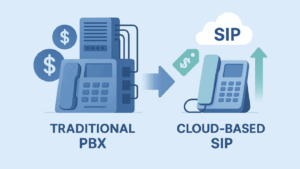
Understanding SIP vs PRI: Which Is Better for Business in 2020?
Despite the importance of office work to our society as a whole, employees that perform these services are often failed by their employers and businesses. This is because only 7% of them feel productive when at work- a dismal statistic that causes restlessness, sadness, and feelings of idleness in workers.
Fortunately, there are ways that you as an employer can ensure that your employees remain within this percentage of those who look forward to getting up and getting at ’em in the morning. One of the major reasons that employees feel unproductive is because of technical difficulties and malfunctions, and this is something really easy for you as the boss to remedy.
You may be considering getting PRI- a landline phone alternative- for your workplace in order to accomplish this. However, the best technology you can get if you want to boost employee productivity and satisfaction is SIP trunking.
Here, we’re going to discuss what each of these calling services are and what they do. After all, only with a thorough understanding of all your options can you make the best decision for your business. Read on to compare and contrast SIP vs PRI!
What is SIP?
Before getting started in discussing SIP vs PRI, it’s crucial to first understand the nuances of this distinction. In this section, we’re going to discuss SIP trunking and how it works. Read on to learn more!
So, What Does SIP Mean, Anyway?
Session Initiation Protocol (SIP) is, at its most basic level, a type of technology that enables you to use your preexisting Wifi network to call others. You can use a SIP trunk to connect with any working phone.
Unless you live under a rock, you’ve used technology like Skype or Facetime in the past. SIP is what allows these programs to start up by enabling Voice over Internet Protocol (VoIP). It’s an initiation software that allows online video or voice calls to be made.
How Does It Work?
SIP is used for communications software. Unlike other calling methods, it can also automatically connect and disconnect to the network when needed as well as modify and transfer communications from one place to another.
As long as you have the appropriate number of SIP channels, your calls won’t cut in and out as often as they otherwise would. Calls also are less likely to be dropped. This means easier use for employees and higher satisfaction for customers.
A good rule when determining how many SIP trunks you need is the 3 to 1 rule. For small businesses under with under 100 employees, you’re generally going to need one trunk for every three people that make calls at a given time.
What is PRI?
Now that you know what SIP is and why it’s awesome, it’s time to learn more about PRI and what makes it unique so that you can make as informed a decision as possible on what technology is best for your business.
What Does PRI Do?
Like SIP, Primary Rate Interface (PRI) technology is a form of telecommunications software. Unlike SIP, it’s an interface of its own, not connected to the preexisting WiFi. Its interface is an Integrated Services Digital Network, which carries voice and data transmissions over a larger network.
PRI is pretty much the standard landline that you imagine when thinking of an office setting. It takes a lot of effort to maintain. You’ll have a T1 and an E1 line through which data is transmitted.
How Is It Used?
PRI uses a circuit-switched model for channeling voice communications. Because of this, you’ll need to purchase and maintain it separately from the WiFi that you also need.
The main reason that some companies use PRI is that there is a guaranteed quality of service that most providers associate with it. This makes sense- after all, it’s a huge system that needs to be kept running. The issue with this, though, is that its quality may not be all that it initially seems.
SIP vs PRI: The Showdown
So you understand what SIP and PRI are- great! It’s time to get into comparing and contrasting these two services. Based on their workings alone, some differences are evident, but there are still more factors to consider.
Key Differences
In recent years, PRI has been going out of favor with businesses. SIP is being brought to the forefront of company operations. It’s an economical and easy-to-set-up alternative to manually connecting a bunch of physical PRI trunks to the telephone lines and dialing them up.
The greatest difference between SIP and PRI is the mode through which they connect people to each other. SIP connects through internet servers, which means that they’re as fast and efficient as the WiFi is.
Many advocates of PRI believe it to be more secure than SIP. While PRI calls are made on a secure network, SIP calls are encrypted with security technology that matches up with that of PRI. In fact, with fraud monitoring in place, SIP may be even more secure.
Financial Considerations
Alright, so SIP is more efficient and secure. But what about the money?
SIP is a lot cheaper to maintain than PRI. PRI installation is extremely expensive, with the money you’ll need to shell out totaling in the thousands.
On the other hand, SIP installation is affordable and only needs to be paid once. You can install the software yourself after paying for the SIP trunks, too, so there’s no need for additional installation costs! On-demand installation has never been easier.
The bills you’ll get for your SIP services are also much lower than those you would have for PRI. While you will get a monthly bill for your SIP trunks in addition to that of your WiFi, it will cost as little as $25a month, maximum. On the other hand, PRI lines with long-distance charges can easily top twice that.
Implications for Business
Because of how easy and versatile SIP trunking is, there are a lot of business implications that go along with making the switch to SIP. Including easier disaster recovery, more predictable bills, and the ability to manage multiple offices and remote workers.
The list of industries that can benefit by using SIP trunks is basically endless.
Start Making Calls!
Deciding between SIP vs PRI may sound like a difficult decision on the surface, but with all the information, the decision is basically made for you. SIP trunking is efficient, affordable, and has an extremely high potential for business benefits. The dying technology that is PRI can’t compete, which is probably why it’s begun to go out of favor anyway.
Now that you know once and for all why SIP is the best calling option for your business, it’s time to get installing some SIP channels. Click here to get started with the most efficient, affordable, and effective SIP services out there!
Good luck, boss!


